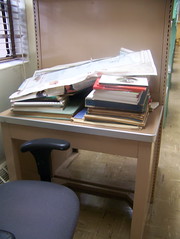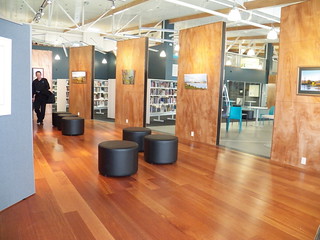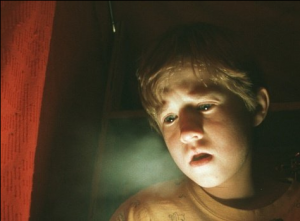
Library Admin is Fun!
Sarah has a great post about her transition to library administrator. Because she feels awkward in that cloth she’ll likely do great.
Naturally, being The Man myself (a few times over), I have my own twist on her observations.
There’s a fine line between being transparent and over-sharing. I don’t believe in transparency so much as translucency. My own boss is a great example of how to share just enough. She’s frank and informative and helps place the world in context, and she finds the positive spin on things or the right solution for the right time. And there are things she doesn’t share with me at the time that I’m glad she withheld (and equally honored that she later shared) — and I’m guessing that’s the tip of the iceberg. I follow her lead.
A lot of my role as The Man is about managing communications: internal, external, whatever — from the signs on the wall to the emails to the masses. I recall a thread on Facebook where a librarian fumed (in a post phrased as a question — not too passive-aggressive, eh) that her director insisted on reviewing all external communications.
Well, yeah, I hope so (though of course in larger institutions that’s managed by a marketing person or an entire department). This is one area where you will need to recommunicate your message frequently. Let me take it farther: I set and enforce expectations for how we will engage with our constituents one-on-one.  I do not apologize for being the chief my-friend-what’s-in-charge of message management, from the signs on our printers to how we communicate computer outages to the flyers distributed to the masses. I’ve walked into the alternative several times in my career and had to undo a lot of damage. You need a united and clear voice.
The Man must be mercilessly optimistic. I’ve flogged that horse so much it found a lawyer and is suing, but I’ll say it again. I can tell it’s time for vacation because it’s becoming a little difficult to be perky and upbeat, but you know what? I’m being paid to be perky and upbeat. Once I walk in the library, that’s my assigned take on the universe. I try very hard to share “good news” as often as I can.
Not only that, it’s my job to ensure that the “optimistic spin” pervades the workplace as much as possible, and to honor and uplift the good moments while deflecting, or at least delaying, the inevitable buzzkill. There are people on this planet who in the name of “just being realistic” have a knack for popping party balloons before the cake has been served; it’s their world-view. Sometimes you will need to sit on them. There will be time to fix the inevitable glitches or problems. People — and that includes you, dear Man — deserve the right, and have the need, to bask in a good moment–to feel a little joy.
Sarah is also right about developing a suit of armor for the people who will never Approve of you… or who project situational Disapproval when you make an unpopular decision. We all want to be liked, but you can’t be the Man and always be liked. Get on that chainmail vest and get over it.
Part of optimism is persistence; a sense of humor helps too. For the last year I have led a “small” project involving an interactive whiteboard in a conference room we created (my former office — I moved next door, and prefer my smaller abode, plus it’s great to have a meeting room /classroom/study room/whatever room). I could go on with the many lessons I have learned from this seemingly easy, now inadvertently hilarious project (in the meantime, we have seen an entire writing center rise up in our library — a collaboration with the English department — among other achievements).
Every single thing about this seemingly innocuous whiteboard project has involved more trial and error, more surprises (not of the good kind), more do-overs, and more unpredicted expenditures than I would have anticipated. I’m not new to projects like this one, but from time to time it came close to besting me.
But it’s all good. No one has died, and lessons have been learned. I feel if nothing else that when we are done I and our IT person, not to mention Jennifer, our kindly rep at CDW, will have earned a Certificate in Audio-Visual Implementation. Go ahead, just ask me about short-throw projectors and controller boards for second-generation interactive dry erase boards — I dare you. And I keep saying: we will get there.
On modesty: I speak here from a higher-ed perspective, and also as a woman. Though I agree it’s my job to make people look good, I would advise caution on deflecting all praise. It’s one thing to hog the limelight and take credit for your team’s good work. But I have found, over the decades, that the response from some people when a woman habitually defers credit for work well done is to take her at face value and agree with her: yes, my dear, you really are full of fail!
Plus, quite honestly, if you are any good, you probably played a role in your team’s ability to succeed (though there are many instances of people succeeding in spite of incompetent bosses). Not only that, the Man soon learns that there are many quiet victories that you cannot share with anyone beyond your boss or another higher-up.
The Man is the Great Protectorate. As much as you have the fiscal latitude to do so, make your staff as comfortable as possible, and make their jobs easier. I do not have the funds to implement true environmental management; our 55-year-old facility is hot in the summer and cold in the winter. But I used year-end reserves to install very nice blinds on the west wall of our library that abate heat in the summer and help retain heat in the winter (and really class up that wall). I also can’t pay staff what they are really worth, but I can ensure they attend conferences, have decent equipment, get the books and training they need, recognition for their efforts, and so on.
Hire very, very carefully. Our uni’s head of HR told me once that when we hire, we hire for life. When we bring someone on board we are impacting their family, our team, the organization. To come to work for your organization is often a huge decision. Even after employees leave, we “own” their history — and they can return in unpleasant (and expensive) ways. Furthermore, they not only follow the organization, they follow YOU. This is stuff I sort of knew (and learned by trial and very unhappy error), but it was still eye-opening to hear it summed up that way.
A bad hire will create havoc in an organization, either immediately and visibly, or incrementally and pervasively. You will make bad hires under the best of circumstances, since the hiring process is one huge chimera and none of us are perfect. But if you know, deep down, this person isn’t right for the job, do not yield to the impulse of hiring anyway so you can fill that job or your head of whatchamacallit can finally go on vacation; and do not bend to any begging or frowning or pouting whatsoever.
This is one area where you really, really are The Man. STOP. DO NOT HIRE. If you are still tempted to ignore your best instincts, remind yourself that every hire is one more ingredient in your succession planning. Do you really want the bad Juju of your successor saying to herself, “What the hell were you thinking..?”
Bad hires are also extremely expensive. I can think of one bad hire (not mine…) at another institution where after the person was paid off to leave, ten years in, the total cost of ownership was easily over a million dollars, salary, benefits, and etceteras included, for someone who was high maintenance and minimal output for the entire period of their employment. That’s not a big salary, by the way, if you factor about 30% for bennies.
You need a mentor, or even Team Mentor. These people are rarely in your chain of command. They may not be other directors (though you do need some experienced director-mentors).
Get out of the library. When people ask me about the value of library conferences, the first thing that comes to mind is the inevitable one-on-ones with cherished friends who will either affirm me or slap me upside the head, depending on what’s appropriate; the second is the ability to stay fresh — to walk back into my library with new ideas and a renewed commitment to the cause.
But stick around the library. I do fewer conferences than at other points in my career, and that’s fine by me. In several positions, I’ve followed administrators who were long-absent for various reasons, and each time I learned that the very best thing I could do is simply “be there.”
Leadership training can be useful. One reason the interactive-whiteboard project became so epic is that I bought the actual whiteboard itself before LIAL (one of a number of good leadership programs), then returned with a renewed awareness of my habit of taking on far more than is realistically doable within a given timeframe. So the whiteboard sat in a box for six months, and when I resumed work on this project, it had Dusty Project Syndrome, which compounded problems. But the insight that I take on too many things and needed to be more intentional was worth it. So was developing a peer group, learning the Harvard case study model, building strategies, and getting “up on the balcony” for a valued perspective.
Take advantage of your current situation. That sounds broad, I know. Where I am now, we are very small and resource-challenged, which has its own baggage. But I’m given a huge amount of latitude and am entrusted to define what library service is; plus I have essentially built Team Library hire by hire. That’s massive.
Most directors walk into organizations with a majority of legacy staff. If you do not have a critical mass of employees who buy into your direction and vision, you’re going to spin your wheels until you change attitudes or people (or both). I’ve met directors at very well-funded institutions who even when they could hire some good people, were simply outnumbered — so both they and their new people could at best crawl very slowly in the trenches toward necessary change, while the forces of stasis chunked rocks at their butts. Many directors also get a lot of external input on what a library should be or do. We have great latitude. I’m mindful of that.
Don’t give up too easily. Don’t give up too early. Beat on problems with sticks (or at least with Red Vines, which are softer and tastier).
I have spent two and a half years delivering the message, “facility improvements in libraries should be informed by professional space planning.” At a low moment, I was helped immeasurably by a nun who commented that a design planning project in the 1980s for a new library wasn’t driven by an articulate vision. It was more “want a pretty building” than “we need X.”
That project fell through — and I’m grateful. We’d all be working in a library built on the brink of the Internet, accessibility awareness, and heavens knows what else, and we’d be the newest building on campus — and therefore the lowest priority.
The funny thing about victory is that sometimes it just sneaks up on you. Suddenly, we were funded for a very high-quality facility assessment. This fall we will do an architectural program with a library space planner. There is now a growing awareness that we can do interesting things with our university’s library space (helped by our carefully-projected message of hospitality and collaboration) — after we gather the facts. It was like water on stone — eventually, water won out, helped by other things, like administrator turnover, our good efforts, and a general mindset change on campus. Having the patience and good grace to let people come around to where you are is key as well.
The facility assessment surfaced an interesting example of taking advantage of our current situation. Our building is very sturdy, and many of the interior walls — and there aren’t too many of them — are nonstructural. I’m sure that was intentional; Milton Pflueger knew his stuff. For space-planning purposes, that kind of flexibility is home-cranked peach ice cream with raspberries on top.
Also work on your instinct for when to set a problem aside for a while, to marinate in the collective consciousness (or perhaps wait for personnel changes). There is a huge gulf between “no” and “not now.” Sometimes Ensuing Events will make a problem much easier to solve; sometimes the problem moots itself, and you can fix other things.
But — save your bullets. Not every issue, or every person, is worth falling on your sword for. Be very choosy. I went to the wall to save the staff sink, and I am still proud of my “win.” I have had other moments, of the kind not reportable, where I have stood my ground (generally place-at-the-table issues). I believe I achieved in part because I saved my bullets for the really important moments. (In terms of personnel, I can recall a time, when I was new to library administration, when I expended several bullets to defend an employee who really wasn’t worth it. Lesson learned.)

Stairwell, 10-29-2009

Metal study desk, October 2009
Finally, because it is so crucial, I want to pick up on Sarah’s point about the small details. These things really make the difference — and they accrue very quickly. I point to Exhibit A, a stairwell, which on the night of my arrival at MPOW sported a peeling poster, patched plaster, and a jumble of library graffiti, as I think of locally-produced signage. The stairwell led to a lower level that was largely deserted because it was dark, dirty, and scary (see Exhibit B: nasty old metal study desks lined a filthy wall; some desks were piled with mysterious junk).
It’s not a gorgeous learning commons (yet…), but it’s now a clean, well-lighted place; see Exhibit C, below. A paint job, new shades, hand-me-down office desks (battle-weary, but pleasantly huge), and $60 lamps from a motel supply store have transformed the west wall on the lower level into a tolerable (if not exactly beautiful) quiet zone. Repainting study rooms and rezoning never-used print journals helped greatly, as well. It’s not the end of what I see for this library, not by a long shot, but it was an important interim fix — a beginning, as it were.

Lower Level Study Desks, September 2010
Convincing Campus Services to replace occupancy-sensor lights with regular switches was crucial to the success of this project — this was make-or-break. Bringing Campus Safety in on the conversation helped; once we had working security cameras installed (yet another milestone), Safety wanted to be able to monitor the lower level. In fact, most of this interim makeover was about communication and collaboration, and commitments of sweat equity, not hard cash.
Campus Services didn’t set out to make the lower level scary — they had simply followed a sensible edict, a few years back, to be environmentally and fiscally conscious. Just as the small stuff became a problem, one issue after the other, so the rehab of this area happened one solution at a time — with a lot of communication mixed in.
And that stairwell is filled with artwork from one of our artists-in-residence; and one project this summer is to work with campus marketing to grow our signage so that this stairwell will guide and tempt users by pointing out that it is, indeed, a decent place to bide a wee, laptop or book in hand. This is just one of many similar “paint and Windex” projects we’ve accomplished. Again, paint-and-Windex is not the destination; it’s important prepwork for the journey, and a reason all of our key indicators keep rising.
It is in fact one of the Man’s responsibilities to teach employees not to “satisfice” — in which they get by with a cumbersome, laborious workaround, or with a miserable situation, rather than solving the underlying problem. Part of that involves making it clear that it’s important to spell out your needs to the Man. A lot of satisficing happens under the guise of “we’re poor” or “it’s not a big deal” when it’s really about discomfort or unfamiliarity with communicating.
Often the Man is delighted to help. Indeed, the Man desperately wants to avoid the accrual of small problems (like the second door into the classroom we didn’t use because it was “broken” — took me a year to investigate — it was actually just sticking a little) — because taken together, these problems are their own message, and like weight gain, after they sneak up on you, it takes a while to undo the damage.
You can get some perspective on satisficing and small stuff through MBWA (Management By Walking Around). Not just in your library, but in the area surrounding it. I rarely take back-door shortcuts into other offices because I use visits to intentionally scan for people I should bump into now and then, and I’m always rewarded. We acquired our first laptop security/charging cart for free when a year or so ago I was walking around campus distributing event flyers, not because we didn’t have people to do that or I was out of things to do, but because it was time for me to put my finger on the pulse of the campus — and someone walked up and said “need this?”
Note: new employees are a boon for pointing out the small stuff. They will ask questions or point out things the rest of us have become inured or blind to. Customer complaints should be heeded too, of course. A customer who complains about the variety of potato chips in the vending machine is one thing. A customer who complains that a printer-copier is making a racket to wake the dead deserves praise for pointing out something we need to know. (Loose Cannon Librarian had a great post about this a few years back, but I can’t dredge it up.)
Finally, money. I too am resource-challenged. Sarah is right about the impact of money, both for people and for stuff. There are thresholds below which you cannot accomplish certain things.
But you may be able to afford other things. Before we were able to offer iPads and laptops for checkout, we began circulating adapters and cables. The adapters make faculty very, very happy, much happier than 3D printing ever would. That’s because that adapter is the last mile to their ability to use a classroom projector, and because libraries are naturally strong at resource management, we nearly always have one on hand.
And once in a while, the fiscal constraint is in my head.
I’ve been working on the funding for replacing the ten-year-old computers in our classroom since I got here; it’s a long, private story. But it dawned on me this spring that while the computers are a serious issue and the replacement project has become epic in its own right, in a kind of higher-ed, how-did-this-become-such-a-snafu manner, I have always, in my grimmest hours, had the funds to replace the computer projectors, which were so dim as to be near-useless. Doing so made a stunning difference in the ability to project in that room, even before the arrival of the light-abating shades.
I was preoccupied with a Big Problem, and (though I’m generally good at this) I didn’t see the molecular components for a while, even though it was obvious that the projectors made instruction challenging. But (to quickly give the Man a little credit, before someone says, “yes, you should have thought of that earlier!”), I did eventually think of it, act on it, and see it through to completion (even in the midst of “breaking up” with one vendor and starting up with another), and let me tell you, 3500-lumens HDMI-capable projectors with zoom and multiple aspect ratios are worth every penny (which is not too many pennies these days, particularly compared to million-dollar bad hires or the cost of a facility so scary it’s never used).
Being the Man is wonderful. Exhausting. Never-ending. All-encompassing. Scary and exhilarating. Addictive, even. And yes, insomnia-producing; I recently proposed to another campus administrator that we hold online meetings at 3 a.m. since it’s obvious from our email traffic that we’re up anyway. Like parenting, you don’t get a time-out from it; once you’ve signed on, you’re all Man, all the time. But quite often, at least for me, that’s more than all right.











 I set aside my pre-
I set aside my pre-





